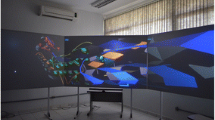Abstract
Due to increases in personal computer power and available bandwidths, 3D worlds are becoming increasingly accessible over the Internet, allowing viewers to freely explore virtual constructed worlds. However, even with advances in computing power and bandwidths, creating realistic 3D worlds which are fast downloading and are pleasurable to navigate around requires a number of design techniques to be employed. The aim of this paper is to describe the design techniques used in a redesign of a web-based virtual reality reconstruction of an historical site describing how different techniques can be used to optimise download times yet retain historical realism. The techniques and processes can be used as a guide by any designer to help create lightweight realistic virtual models.












Similar content being viewed by others
References
BBC History Web Site (2005) World War One Trench 3-D Virtual Tour. [Online]. Available: http://www.bbc.co.uk/history/war/wwone/launch_vr_trench.shtml [2005, May 13]
Bolter JD, Gromala D (2003) Windows and mirrors, interaction design, digital art and the myth of transparency. MIT Press, Cambridge Massachusetts, pp 40
Conner B, Holden L (1997) Providing a low latency user experience in a high-latency application, Proceedings ACM Interactive 3D graphics ‘97, April 27–30, 1997, Providence, Rhode Island, United States, pp 45
Davis SB (1996) The DESIGN of virtual environments with particular reference to VRML. Report for the advisory group on computer graphics, Middlesex University, 4:61–65
Gzip (2005) Patent free compression utility. [Online]. Available: http://www.gzip.org/ [2005, May 13]
Hartman J, Wernecke J (1996) The VRML2.0 Handbook, building moving worlds on the Web. Silicon Graphics Inc., ISBN 0-201-47944-3
Henderson J (1991) Designing realities: interactive media, virtual realities, and cyberspace. In: Helsel S, Roth J (eds) Virtual reality, theory, practice and promise. Meckler, pp 66–72
Kantner J (2000) Realism vs reality: creating virtual reconstructions of prehistoric architecture. Virtual reality in archaeology, Archeopress, Oxford, pp 1–5
Sense8 (2005) Graphic based VR modelling software. [Online]. Available: http://sense8.sierraweb.net/ [ 2005, May 13]
Waltery B, Drettakisy G, Parker S (1999) Interactive rendering using the render cache, rendering techniques ‘99 (Proceedings of the 10th Eurographics Workshop on Rendering, Springer-Verlag/Wien 10:235–246
Yuan P (1999) Benchmarking mesh simplification algorithms in real-time rendering applications. Presented at western computer graphics symposium SKIGRAPH’99. pp 1
Zari M, Saiedian H, Naeem M (2001) Understanding and reducing web delays. Computer 34 12(Dec.):30–37
Author information
Authors and Affiliations
Corresponding author
Rights and permissions
About this article
Cite this article
Badni, K. Virtual reality design techniques for web-based historical reconstructions. Virtual Reality 9, 215–225 (2006). https://doi.org/10.1007/s10055-005-0008-0
Received:
Accepted:
Published:
Issue Date:
DOI: https://doi.org/10.1007/s10055-005-0008-0




